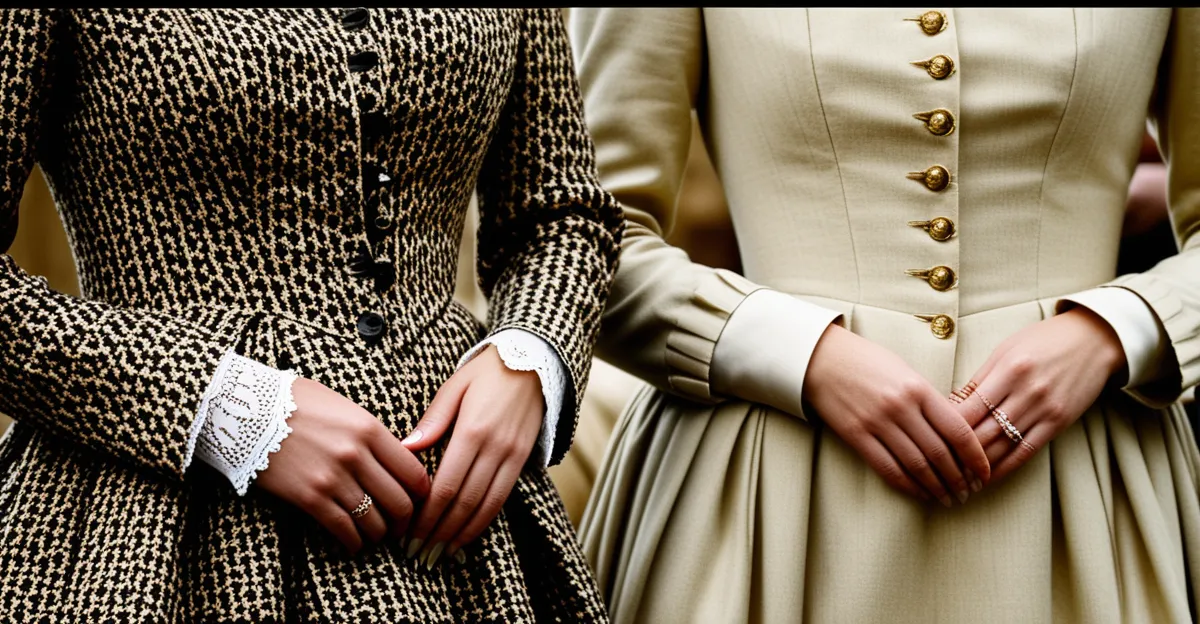Chronology of Key Historical Events Shaping UK Women’s Fashion
The timeline of UK women’s fashion history reveals how pivotal historical events molded evolving dress codes and styles. Beginning with the Victorian era, fashion echoed societal norms of rigid etiquette and elaborate detailing, reflecting women’s constrained roles through restrictive corsets and voluminous skirts. The dawn of the 20th century, influenced by changing political and economic climates, initiated a remarkable shift.
During World War I, practicality became essential as resources dwindled, sparking early adaptation of more functional attire. These wartime conditions set the stage for further transformation; the interwar period and World War II accelerated changes with rationing and utility clothing, challenging previous extravagance in fashion.
Also to see : How Can You Transform Your Wardrobe with Essential UK Women’s Fashion Pieces?
The 1960s marked a cultural and social revolution that redefined women’s roles and, consequently, their fashion. Designers embraced youthful liberation and modernity, evident in bold prints and shorter hemlines. This era underscored the intricate interplay between political movements and fashion innovation, as clothing became a symbol of self-expression and empowerment.
Each epoch in this historical continuum offers insight into how shifts in society directly influenced UK women’s fashion history, underscoring the dynamic evolution inspired by broader historical currents.
Topic to read : How Can You Transform Your Wardrobe with Essential UK Women’s Fashion Pieces?
The Impact of Wartime on Women’s Fashion
Wartime fashion dramatically reshaped UK women’s clothing, driven by material shortages and government mandates during both World War I and World War II. The scarcity of fabrics led to strict garment rationing and the introduction of utility clothing, designed to be practical, durable, and economical without sacrificing style. This period marked a clear shift towards functionality, with simpler silhouettes replacing elaborate Victorian designs.
World War I demanded that women occupy roles traditionally held by men, pushing practicality in women’s workwear. Overalls, trousers, and tailored jackets became common as women worked in factories and offices. During World War II, austerity intensified, reinforcing utilitarian style through standardized uniforms and limited ornamentation, reflecting the evolving gender roles in society and the workforce.
This wartime necessity directly influenced postwar fashion trends by promoting comfort and accessibility. The evolution of wartime fashion illustrates the powerful link between historical events and UK women’s fashion history, highlighting how external pressures precipitate rapid changes in dress codes and style preferences. The timeline of these developments showcases fashion’s responsiveness to broader societal needs and constraints.
The Suffrage Movement and Shifting Dress Codes
The women’s suffrage movement in the early 20th century significantly influenced UK women’s fashion history by redefining dress as a form of political expression. Suffragettes used clothing strategically—wearing emblematic colors and practical attire—to challenge traditional gender norms and advocate for voting rights. This symbolism marked a clear departure from the earlier prevalence of restrictive garments like corsets and bustles.
As political movements gained momentum, women embraced looser, more functional styles that reflected their growing public presence and activism. The decline of cumbersome apparel paralleled expanding gender roles, with fashion becoming not just about appearance but also a statement of autonomy.
This period advanced the timeline of UK women’s fashion history by accelerating the evolution toward practicality and personal freedom in dress. Newly gained political rights empowered women to experiment with styles that prioritized comfort and independence, laying groundwork for later fashion innovations. The intertwining of historical events and fashion during this era illustrates how societal change directly impacts cultural and stylistic norms, making the suffrage movement a pivotal chapter in the broader narrative of UK women’s fashion history.
Postwar Prosperity and the Rise of Fashion Icons
Postwar fashion in the UK was deeply shaped by an economic boom in the 1950s and 1960s, marking a sharp turn from wartime austerity to luxury and innovation. This prosperity allowed designers to experiment with new materials and styles that celebrated freedom and creativity, greatly impacting UK women’s fashion history.
Key British fashion icons like Mary Quant and Twiggy emerged during this era, revolutionizing clothing with youthful, daring looks such as miniskirts and mod outfits. Their influence extended beyond style, symbolizing a broader social change that embraced individuality and youth culture.
London’s rise as a global fashion capital during this period was fueled by the mod movement, which championed bold colours, geometric patterns, and streamlined silhouettes. This movement connected fashion innovation with wider cultural shifts, including greater gender role fluidity.
The timeline of postwar prosperity highlights how historical events like economic revival and shifting societal attitudes directly propelled the evolution of UK women’s fashion, bridging earlier austerity with vibrant, experimental aesthetics that continue to inspire today’s designers.
Cultural Revolutions and Changing Attitudes in Late 20th Century Fashion
The late 20th century’s cultural revolution radically transformed UK women’s fashion history by introducing unprecedented diversity and individualism. The 1970s and 1980s saw the rise of punk fashion, characterized by rebellious, DIY aesthetics that challenged mainstream norms. This period’s timeline of style innovation reflects how subcultures like punk and New Wave shifted dress codes from uniformity to creative personal expression.
These decades expanded the definition of femininity, incorporating bold prints, asymmetrical cuts, and unconventional materials. Political and social activism intertwined with fashion, heralding a broader acceptance of style as a form of identity and resistance. The effect of globalisation and multiculturalism further enriched UK women’s fashion history by introducing fabrics, designs, and influences from diverse cultures, reshaping fashion’s role in society.
This era’s historical events highlighted a profound break from past constraints, allowing women to experiment freely and advocate for inclusion through dress. The evolution of UK women’s fashion during this time is a testament to how political and cultural shifts continually redefine sartorial landscapes, making late 20th century fashion a pivotal chapter in the ongoing timeline of style innovation.
Ongoing Influences: Modern Social Movements and Contemporary Fashion
Modern fashion in the UK reflects significant shifts driven by feminism, sustainability concerns, and ongoing social change. Contemporary feminism profoundly impacts UK women’s fashion history by promoting empowerment and inclusivity. Clothing now serves not just aesthetic purposes but also as a means to assert identity and gender equality. This evolution is a direct continuation of the political and cultural shifts seen in earlier historical events.
Sustainability has emerged as a critical factor in present-day fashion, with many designers and consumers prioritizing ethical production and sustainable materials. This movement addresses the environmental impact of traditional garment manufacturing, encouraging slow fashion and recycling. The timeline of UK women’s fashion history now increasingly incorporates sustainability as a core theme, reflecting broader societal values.
Digital culture accelerates these developments by spreading trends rapidly and giving voice to diverse communities. Social media platforms enable designers and consumers alike to influence the fashion narrative, fostering inclusivity and innovation. Together, these modern social movements shape a vibrant, conscientious trajectory in UK women’s fashion history, underscoring its dynamic evolution.










